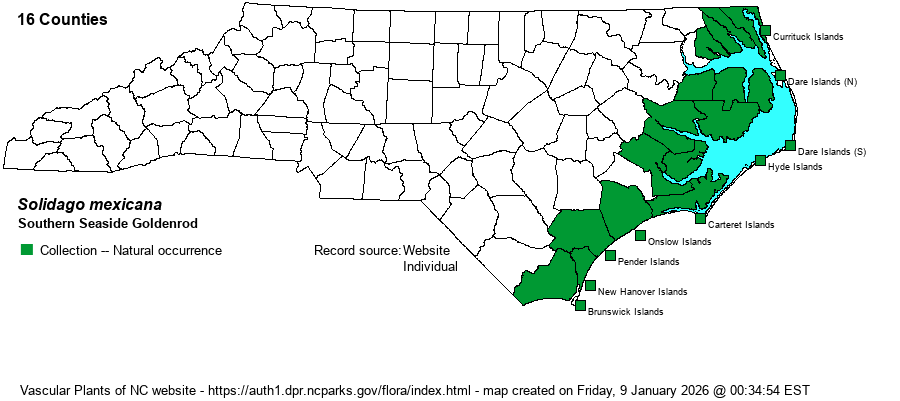| Section 6 » Family Asteraceae |
Show/Hide Synonym
| taxonName | relationship | relatedTaxonName | relatedTaxonRefText | relComments |
|---|
|
| Solidago mexicana | = | Solidago sempervirens var. mexicana | Gleason and Cronquist (1991) | | | Solidago mexicana | = | Solidago sempervirens var. mexicana | Fernald (1950) | | | Solidago mexicana | = | Solidago sempervirens var. mexicana | Gleason (1952) | | | Solidago mexicana | = | Solidago sempervirens var. mexicana | Godfrey and Wooten (1979, 1981) | | | Solidago mexicana | = | Solidago sempervirens var. mexicana | | | | Solidago mexicana | = | Solidago sempervirens var. mexicana | Kartesz (1999) | | | Solidago mexicana | = | Solidago sempervirens var. mexicana | Vascular Flora of the Southeastern States (Cronquist 1980, Isely 1990) | | | Solidago mexicana | = | Solidago sempervirens var. mexicana | Flora of Virginia | | | Solidago mexicana | < | Solidago sempervirens | Radford, Ahles, and Bell (1968) | | | Solidago mexicana | < | Solidago sempervirens | Wunderlin & Hansen Flora of Florida (3) | | | Solidago mexicana | = | Solidago sempervirens ssp. mexicana | Flora of North America (1993b, 1997, 2000, 2002a, 2002b, 2003a, 2004b, 2005, 2006a, 2006b, 2006c, 2007a, 2009, 2010) | | | Source: Weakley's Flora |
|
| Author | L. | |
| Distribution | Note that S. sempervirens has recently been split into two species, and the one present over nearly all of the NC coast is now S. mexicana; the other species is more northerly, south only to Cape Hatteras. S. mexicana occurs in the Outer Coastal Plain, Outer Banks, and other barrier islands.
Coastal Plain, southeastern MA to southern FL, southern TX; Mex.; W.I. | |
| Abundance | Common to locally abundant in tidal regions along the coast, and around the inner portions of sounds and embayed rivers. This species is not in the NCNHP database or in BONAP; the website editors consider it has a State Rank of S5 and a Global Rank of G5 as well. | |
| Habitat | Brackish marshes, freesh-tidal marshes, interdune swales, wet maritime grasslands, roadside ditches near the coast. This is one of the most often seen members of the aster family in estuarine habitats. | |
| Phenology | Flowering and fruiting late August-November. | |
| Identification | This species grows 3-6 feet tall and often has several stems in a bunch. The stem and leaves are glabrous. Leaves are numerous, lance-shape, untoothed, succulent (fleshy to the touch), and taper-pointed; the middle and upper ones are strongly ascending to erect, while lower ones may be rather spreading. The inflorescence has widely spreading branches, and heads grow only on one side. It is distinguished from the very similar S. sempervirens by an erect habit, less succulent foliage, widely spreading inflorescence branches, and habitat preference. Weakley (2018) also notes that this species has the larger leaves less than 3 cm wide, whereas S. sempervirens has larger leaves greater than 3 cm wide; and this species has flowers with only 7-11 rays, versus 12-17 rays in the other species. The Outer Banks lie in the zone of overlap, and occasional plants are difficult to tell apart. | |
| Taxonomic Comments | Some authors treat it as a variety or subspecies of S. sempervirens. Most references did not or do not split out the two taxa at all and just list S. sempervirens.
| |
| Other Common Name(s) | None. Of course, most references simply call it as Seaside Goldenrod, but because there are now two such species, each needs a modifier name -- Southern in this species. | |
| State Rank | [S5] | |
| Global Rank | [G5?] | |
| State Status | | |
| US Status | | |
| USACE-agcp | | |
| USACE-emp | | |

